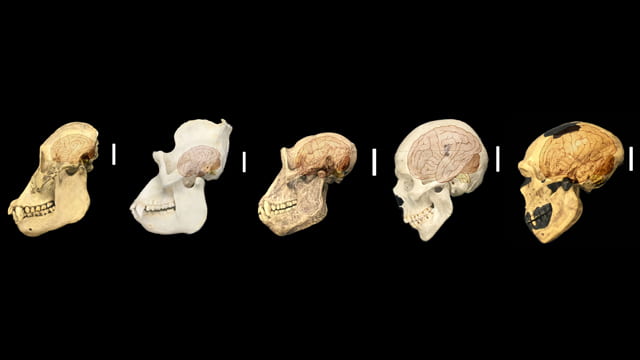May 31, 2018
Three members of a gene family called NOTCH2NL may have been involved in the evolution of humans’ big cortex.
In the last few million years, the brains of humans and human ancestors have quickly evolved to be much bigger and more complex than their primate relatives. The genetic and molecular mechanisms that drove this expansion are still poorly understood, but two studies published today (May 31) in Cell describe a new gene family unique to humans that may have played a role in building bigger brains. The NOTCH2NL gene family is expressed during human cortical development and promotes neural progenitor cell renewal, which leads to more neurons.
We have an exceptional opportunity to find the changes that occurred in our ancestors’ DNA that made us human.
—David Haussler,
University of California, Santa Cruz
“We know very little about how human-specific genes . . . might impact brain evolution and this [work] provides some really important insights,” says Debra Silver, a neuroscientist at Duke University in North Carolina who did not participate in the studies. “Both studies have used complementary approaches to investigate Notch’s role in progenitors, and they’re seeing really similar outcomes.”
“Usually in biology, we tend to think that it’s the things that are highly conserved that are very important,” says a coauthor of one study, Pierre Vanderhaeghen, a developmental neurobiologist at the Université Libre de Bruxelles and Katholieke Universiteit Leuven in Belgium. “If we only look at the things that are super conserved, we’re never going to find out what goes on during human evolution [because] the human-specific genes by definition are not present.”
A natural experiment to boost neural progenitors
In order to investigate unique human genes involved in cortical development, Vanderhaeghen and colleagues sequenced RNA from human fetal cortical tissue collected after medical pregnancy terminations that occurred between seven and 21 weeks of gestation. They identified 35 genes specific to humans and their immediate ancestors with open reading frames that suggested the genes actually code for proteins. The 35 genes arose through gene duplications and were part of 24 gene families.
The researchers then electroporated members of nine of the gene families—selected based on their expression in progenitors during cortical neurogenesis—into the brains of developing mice. They found that gain-of-function of a particular gene, NOTCH2 N-terminal like B (NOTCH2NLB), maintained cells in a progenitor state, rather than following their typical timeline of differentiation. NOTCH2NLB is related to NOTCH2, which is conserved across mammals and known to be involved in neurogenesis via the Notch signaling pathway.
[ Read more ]


Recent Comments